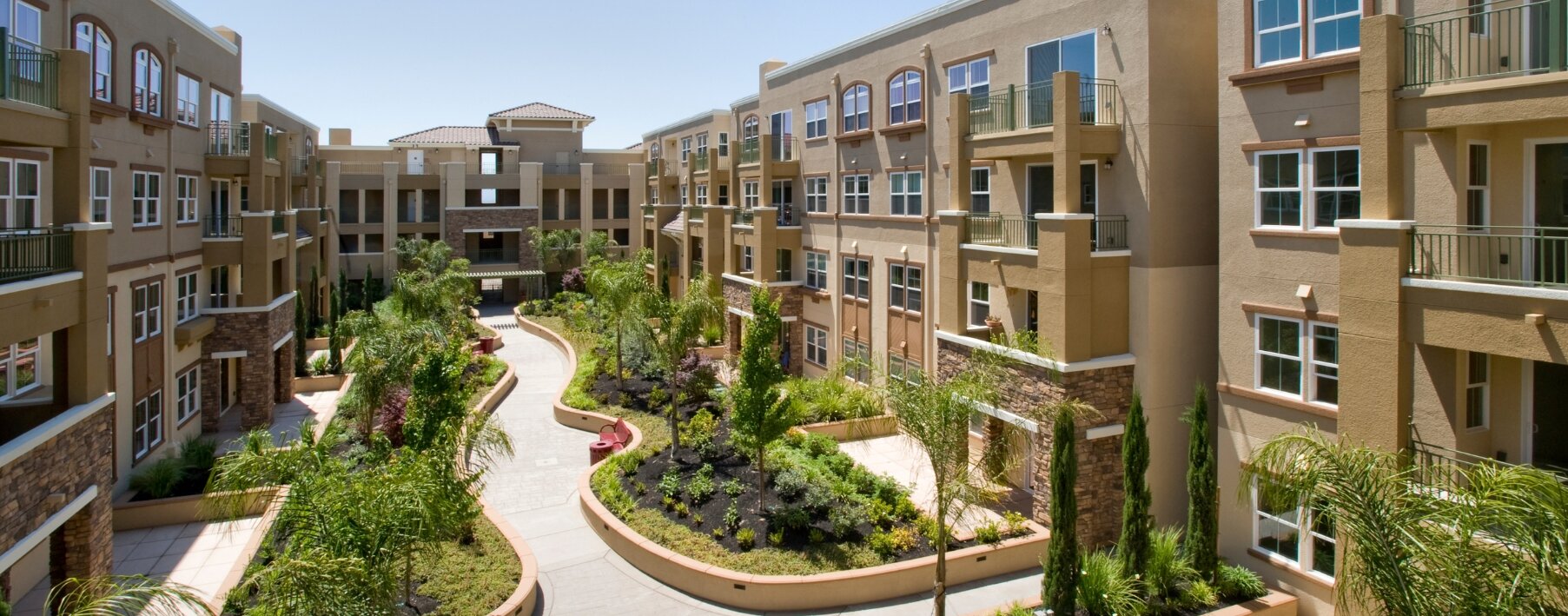Parts of a House: Get To Know Every Part of Your Home
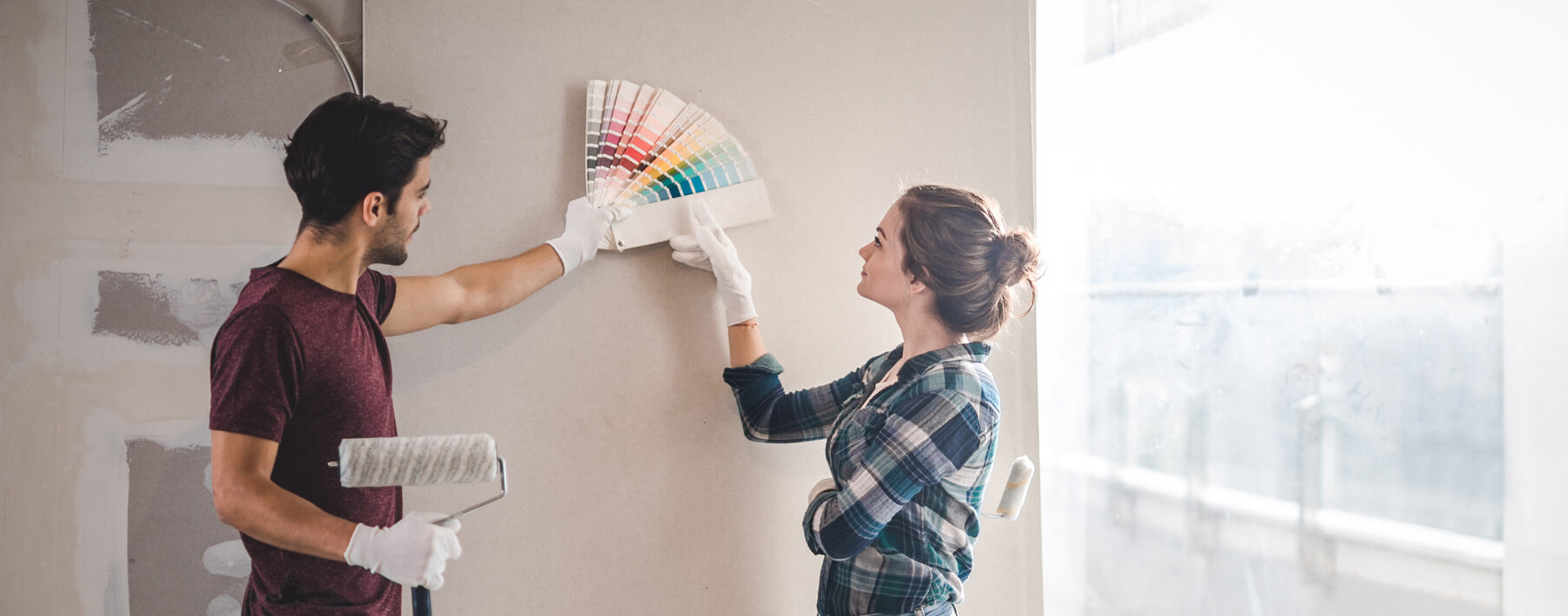
There’s a lot that goes into making your house a comfortable living space. Every room, floor and each nook and cranny have their own unique purpose. Getting to know each part of your house can help you most effectively utilize your space. That way you can ensure that your home can take care of all of your specific needs, as well as what type of smart home trends could work for each room. According to a report by the Insurance Information Institute, 49% of homeowners have documented losing their possessions.
It should come as no surprise that not knowing where things are located around the house, like the fusebox or water shut-off valve makes it easy for you to lose sight of the risk of damaging your belongings in the case of an accident. For example, did you know that recovering lost items costs Americans $2.7 billion each year? Familiarize yourself with your home from the inside, out so that you don’t have to end up dipping into your coverage to replace any lost or impaired items.
For example, it’s not uncommon for homeowners to sometimes experience difficulty locating the main water shut-off valve or fusebox. To put this into perspective, the Environmental Protection Agency reported that households in the United States can face up to one trillion gallons’ worth of leaks per year.
Not to worry: Taking the time to familiarize yourself and your household with these features of your home can help prevent damage from occurring in the first place. That’s why we created this guide to help you get to know all the different parts of your home.
What are the different parts of a house?
The main parts of a house can be categorized as the frame, the exterior, the interior and the division of rooms. While no two houses are completely the same, the basic structure of a house is more or less uniform. See below for the breakdown of all the spaces you need to know about.
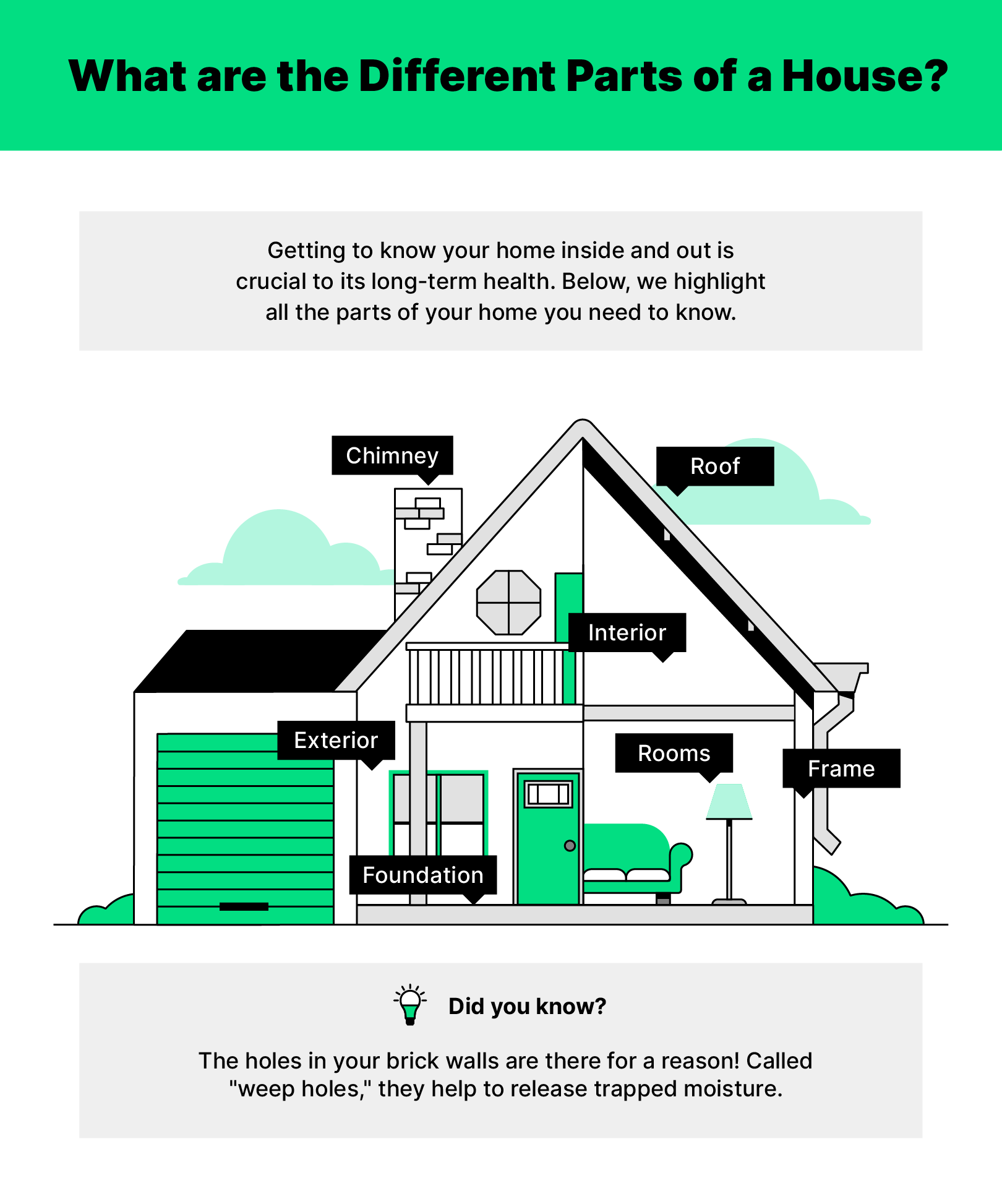
Frame
The frame is one of the first parts of the house that is built in the construction process. Think of it as your home’s skeleton, giving you an idea of what the shape of the house is going to look like.
Understanding the condition and age of your house’s frame and locating load-bearing beams are key for homeowners to know because depending on the materials used and when it was built, you could be at risk of it collapsing during a major weather catastrophe.
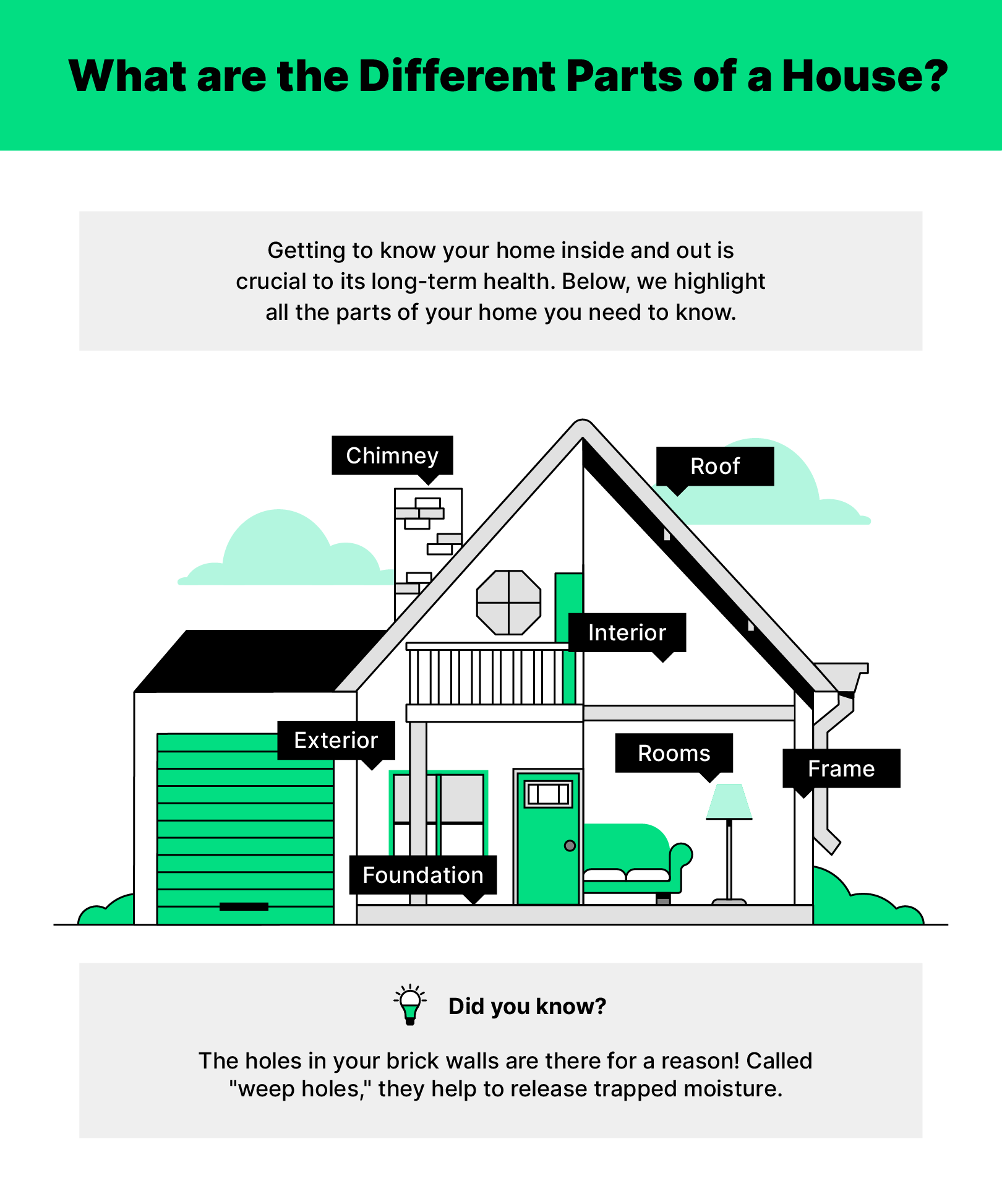
Exterior
The exterior of a house refers to all the aspects that are outside and exposed to nature. Some examples include the siding, your roof and even windows and doors. All of these elements help keep the house insulated from extreme weather conditions, and when well-kept, can even work in your favor to boost curb appeal.
If you are unsure about where all of these exterior elements are situated throughout your home, it’s a good idea to take inventory of their location, what materials they are made of and the state that they are in. This could help you keep your home safe and even lower your home insurance in the future, especially if you decide to revamp something to a newer, sturdier version.
Some of the exterior features include:
- The front, back and side doors: located along the house
- Garage doors: typically in the front or around the side of the house facing the main street
- Windows: built into the walls
- Porch: can be found along the front, back, and sides of the house surrounding the exterior walls
- Balcony: usually an extension of one of the rooms in the upper levels of the house
- Backyard patio: often serves as a sort of deck extending the living area from inside to out
- Chimney: typically originates from the fireplace into the ceiling and out through the roof
- Roofing material (tile, ceramic, etc.): incorporates everything used for the exterior portion of the house ceiling
- Gutter: horizontal metal pipes used along the edges of the roof to gather rainwater coming from the roof and into the downspouts
- Driveway: the path that leads from the street and onto the property
- Drainpipe: normally located close to the home accompanying the main sewer line in a series of clusters
- Alarm system: mounted along one of the walls on the inside or outside of the house
- HVAC system: can be found inside or outside the house, oftentimes split halfway down the middle and inserted in both the inside and out
- Fusebox: most commonly located on the outside of the house along one of the side walls
- Water shut-off valve: found anywhere from 3-5 feet away from where the water enters the home
- Service lines: a group of wires located around the exterior of the home (mostly found underground) that supply electricity, water, and sewage services, while connecting the property to the city’s main supplies
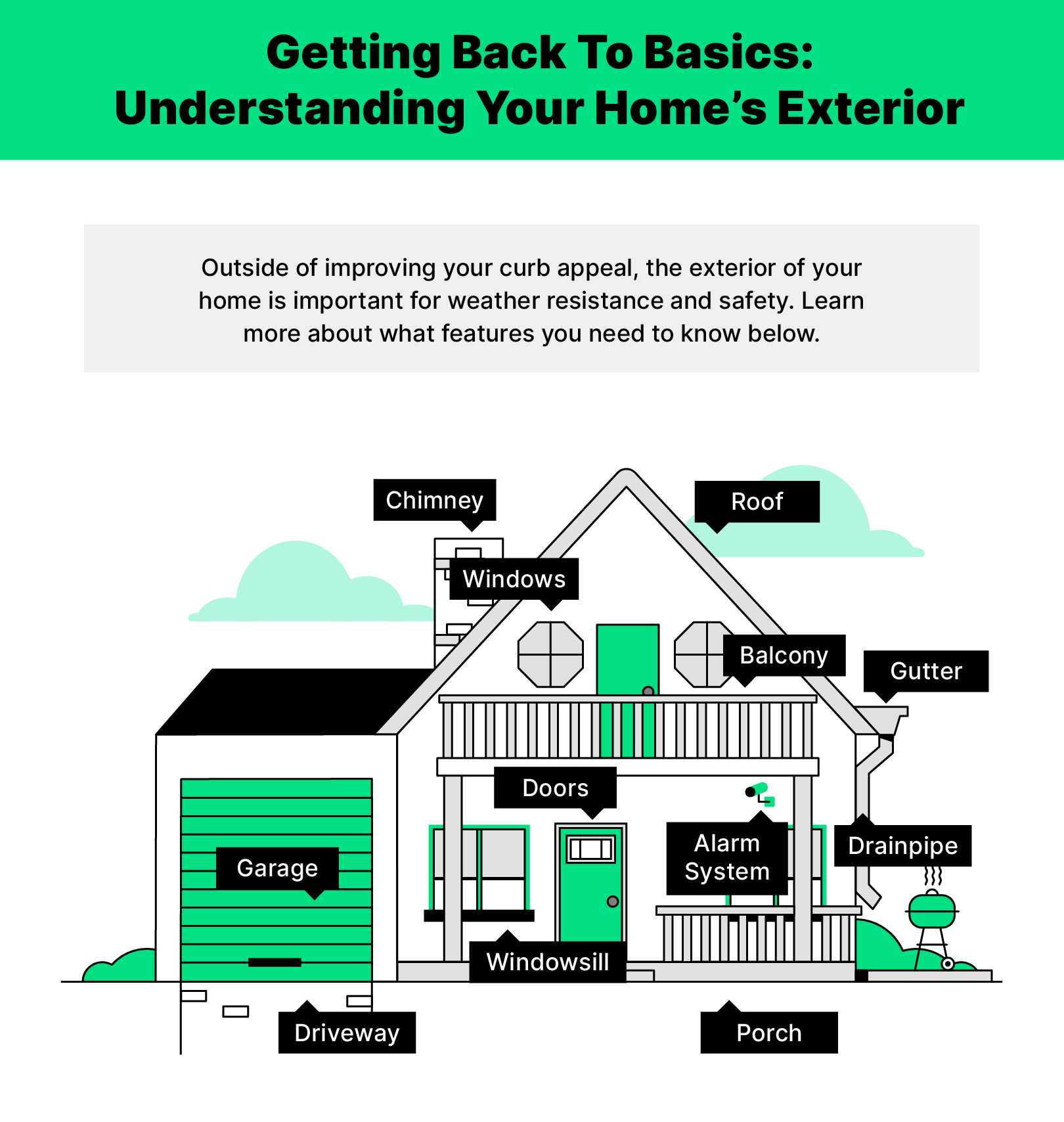
Interior
The interior is everything within the home’s structure, such as the walls, flooring, outlets and everything in between. It’s important for homeowners to know every part of their home’s interior because keeping each feature in tip-top shape can help you avoid costly issues in the future.
Examples of what you might find in the house interior:
- Walls: used to separate rooms and assist with supporting the frame
- Lighting: used to illuminate the space and typically found on the ceiling of each room or hallway
- Light switches: used to turn lights on/off and found along at least one wall per room at eye level or below
- Doors: used at the entrance/exit to each room
- Outlets: used to plug in electronic devices and inserted into the walls at ground level
- Plants: used for decorative and therapeutic purposes and found anywhere throughout the house
- Furniture: used anywhere in the home space to provide comfort, functionality and appeal to the home and
- Personal belongings: any items or possessions that belong to the inhabitants of the house
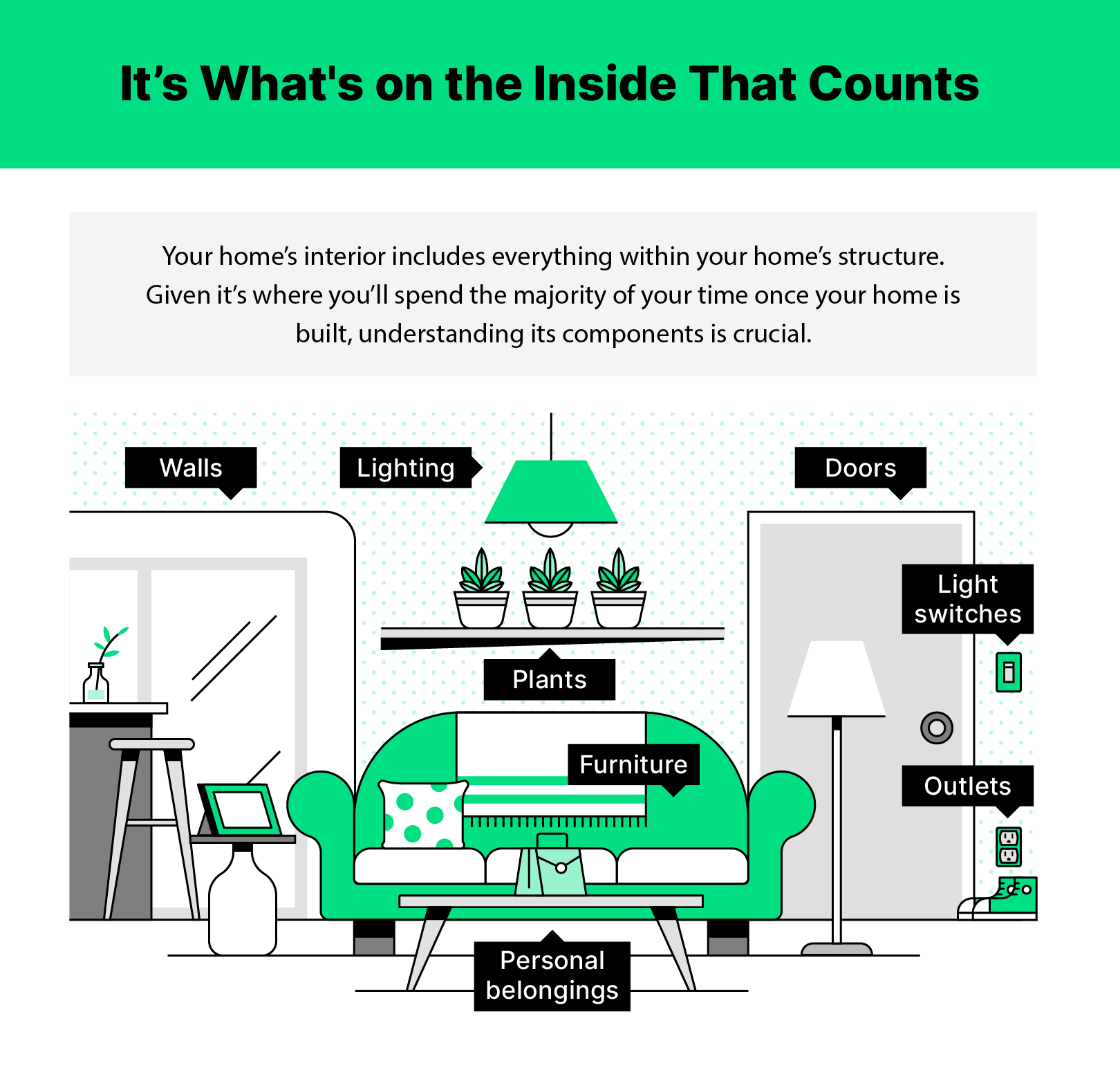
What is the basic structure of a house?
The basic structure of many modern houses includes a foundation, frame, roof, door, chimney, windows, garage, yard, driveway and mailbox. Knowing the different types of elements that you may come across for a roof or foundation can help you further down the line when dealing with anything from maintenance to repairs and renovations. See below for a description of each part, along with basic things to look out for.
Foundation
The foundation of the house is one of the first pieces that is laid out during its construction. The thicker and higher quality the foundation a house has, the longer it will last before encountering any problems.
If you recently moved into your home or are unsure of the condition of the foundation, have a professional come in for an inspection. Many new homeowners often conduct inspections of their home before moving in. Foundation problems can be costly, complicated and time-consuming.
Make sure you know what kind of foundation your home has and the condition it’s in, this will help you know how to keep it in good condition.
Types of foundation:
- Concrete slab foundations
- Basement foundation (full vs. daylight)
- Crawl space foundation
- Pier foundation
- Wood foundation
- Poured concrete foundation
- Precast concrete panel foundation
- Concrete masonry units
- Stone foundation
- Footing and stem wall foundation
- Pier and beam foundation
Some common foundation issues include:
- Cracks and other types of fractures on the wall/floor
- Foundation upheaval
- Foundation settling or sinking
- Doors that stick open or do not close properly
- Gaps around the exterior doors and window frames
- Uneven or unstable floors
- Cabinets and counters separating from the walls
- Damp crawl spaces
Taking care of your foundation now can help avoid running into problems in the future.
Roof
The roof is the top covering of the house’s physical structure and includes all the materials necessary to keep the house protected and unharmed from outside weather conditions. There are several types of roofs to choose from depending on the style of the home and the local climate. Some homes have slanted tile roofing to keep snow from piling up, while others have metal roofs to assist with temperature control (very helpful in desert climates).
If you’ve ever experienced a leaky roof, you know just how inconvenient it can be, especially in the case of major weather occurrences. Over time, leaks can cause severe or even permanent damage to your roof or property. So when in doubt, check that roof out.
Types of roofs:
- Gable roof
- Hip roof
- Dutch roof
- Mansard roof
- Flat roof
- Shed roof
- Butterfly roof
- Gambrel roof
- Dormer roof
- M-shaped roof
Common roof problems:
- Roof leaks
- Damaged flashing
- Broken or missing shingles
- Granules clogging downspouts
- Stagnant or pooling water
- Tree damage
- Damaged roofing materials
Chimney
Chimneys were traditionally built as air vents to let out smoke from a home’s fireplace or coal-burning stove. They typically start as an opening coming from inside the house that leads up and out of the roof. Most modern homes do not possess chimneys, so this is likely not something most people need to be concerned about.
If your home does possess a chimney, be sure you become familiar with how to maintain it.
Types of chimneys:
- Masonry chimneys
- Metal chimneys
- Factory-built/prefabricated chimneys
- Fireplace-insert chimneys
- Freestanding stove chimneys
- Wood burning stove chimneys
Common issues with chimneys:
- Creosote buildup
- Cracked or spalling bricks
- Damaged mortar
- Missing chimney caps or chase covers
- Cracks in the chimney flue
- Chimney obstructions
- Rotting wood
Window
If you’ve ever written “lots of natural light” on a house-hunting checklist, you know how important windows are. Windows, meant to invite natural light and fresh air into the space, can also help insulate heat in a home during cold weather. But, unfortunately, the opposite can occur if the window is old or not working properly.
Luckily, they are made to last, so if you do end up having to switch out your windows, it’ll easily be one of the best long-term investments you could make for your home. If you don’t want to replace your windows just yet but are concerned they aren’t working properly, try resealing their edges with a weatherproof bonding material.
Types of windows:
- Hopper windows
- Fixed/picture windows
- Single-hung windows
- Double-hung windows
- Custom shaped windows
- Bay windows
- Side slider tilt windows
- Awning windows
- Bow windows
- Single slider tilt windows
Commons problems with windows:
- Difficulty to open
- Fogging windows
- Drafting windows
- Warping or rotting
- Broken windowpane
- Water leaking through
Door
A door is a large piece of wood or some other material that fits into the entryway of the house. Doorways can come in various shapes and sizes. French doors, for example, are a style that involves two doors side by side with the doorknobs located at the interior center of each.
Doors are meant to keep you in and everything else out. If you plan on leaving your home for the holidays or an extended vacation, and want some added protection, then you may wish to look into smart home devices to help monitor your home while you’re away.
Types of doors:
- Wood doors
- Steel doors
- Fiberglass doors
- Aluminum doors
- Glass doors
- Battened and ledged doors
- Flush doors
- Dutch doors
- French doors
Common issues with doors:
- Door hinge problems
- Doors that won’t stay latched
- Doors that draft
- Bottom wall plates that are misaligned
- Trims that do not fit in the space provided
- Warped door
Balcony
Generally speaking, a balcony is a platform that is enclosed by a low wall or a railing above the ground floor of a house that overlooks the back or front yard. Some balconies extend across an entire floor, while others contain limited access through only one room. Not every home has a balcony.
Over time, some balconies may become unstable or in need of repair. The most common types of balcony fixes generally require switching out the platform or the hand rail — the metal structure that keeps you from walking off the edge. During the winter months, especially in areas that experience blizzards, it’s also a smart idea to cover your balcony to provide added protection from the weather.
Types of balconies:
- Hung balcony
- Stacked balcony
- Projected or cantilever balcony
- Bolt-on or self-supporting balcony
- Juliet balcony
Common problems with balconies:
- Construction defects
- Moisture problems
- Structural deficiencies
Garage
The garage is the room in the house meant to keep the car and other storage items safe from weather or theft. Most garages come equipped with automated doors and remote controls, and some may even be detached from the house entirely. Detached garages are often turned into a home den or additional bedroom that can be used for guests or tenants.
Some people like to convert their garage into a room they can rent as a way to generate income. Regardless of whether you are the landlord or the tenant, it's a good idea to consider obtaining renter’s insurance as a way to ensure that protection is extended to all parties involved.
Types of garage:
- Detached garage
- Attached garage
- Internal garage
- Portico garage
- Workshop garage
- Carport
- Barn garage
- Carriage house garage
Common issues with garages:
- Garage door opener doesn’t work
- Garage door doesn’t close completely
- Cracks in garage flooring
- Loud garage door
- Garage door becomes stuck
Driveway
The driveway is the space in between the beginning of the property and the front door or garage opening. It is most commonly paved by concrete, stones or other weather-proof materials. Driveways can come in a lot of different styles. They can be long, wide, straight, narrow, curved, or anything in between.
Types of driveways:
- Concrete driveway
- Brick driveway
- Asphalt driveway
- Gravel driveway
- Crushed stone driveway
- Paver driveway
- Basalt driveway
- Cobblestone driveway
Common problems with driveways:
- Bulged driveway
- Cracked driveways
- Sinking driveways
- Crumbling driveway
- Uneven driveway
Yard
The yard is the outdoor space that covers the front, back and sides of the house. It is typically landscaped with anything from grass and flowers to fruit trees and potted plants. Some yards can be lush and rich with a diverse array of plants, while others may contain a more simple or totally open layout.
Landscaping your home’s yard can be expensive and often require a lot of maintenance. If you happen to be looking for a more sustainable and economically viable way to landscape your yard, check out this guide to xeriscaping.
Types of yards/gardens:
- Vegetable garden
- Flower garden
- Rock/stone garden
- Herb garden
- Indoor garden
- Tropical garden
- Greenhouse garden
- Botanical garden
- Therapeutic garden
- Succulent garden
- Bamboo garden
- Xeriscaped garden
- Vertical garden
- Ornamental grass garden
Common yard/garden problems:
- Crabgrass
- Dandelion
- Yellow nutsedge
- Compacted soil and improper aeration
- Thatch and brown patches
- White grubs and insects
Mailbox
The letterbox, more popularly known as a mailbox, is the small box often located somewhere in front of the house. While mailboxes often look like small tins, people use them as a way to display their personal flare. Not every household has its own mailbox; some homes use the Post Office or may have community boxes opened with a card, passcode or key.
As a homeowner, you likely want to know when any bills or documents come in the mail and checking your mailbox regularly is a good way to stay on top of this.
Types of mailboxes:
- Collection boxes
- Mail slots
- Apartment mailboxes
- Wall-mounted mailboxes
- Pedestal mounted boxes
- Freestanding mailboxes
- Parcel boxes
Common issues with mailboxes:
- Wet or damaged mail
- Missing delivery or burglary
- Stuck mail doors or hinges
What are the seven rooms in a house?
While residential homes can have a variety of room types, the seven most common rooms that you’ll likely find in a house are the bathroom, kitchen, living room, dining room, bedroom, laundry room and den or office space. While no two houses are exactly the same, most houses usually include their own version of these seven rooms.
Of course, your home should be an expression of you and your family and certain rooms have the ability to serve more than one purpose as you update from year to year. What is most important is that these rooms suit your lifestyle and your needs.
Smart home devices for every part of your home
Once you become familiar with every part of your home, it may be time to see what types of upgrades make sense. Adding smart home devices and/or appliances can only make it better. Here at Hippo, we provide smart home kits that include ways to help you save up to 25% on your annual insurance premium.
See below for some ideas of what you can do to upgrade any room in your house to discover new levels of comfort, convenience and functionality.
Bathroom
Parts of a House: Get To Know Every Part of Your Home





If you are unsure of whether to renovate and want the highest return on your investment, start with the bathroom. Adding smart bathroom technology can make you feel more comfortable and potentially raise your property value.
Smart home ideas for your bathroom: water recycler, floatation tub, smart faucets, smart scale, floor heating system, smart shower, adjustable privacy glass and interactive LED mirrors.
Kitchen
If you find that you spend the most time in the kitchen, then this may be the time to add on some nifty kitchen technology. As one of the most utilized rooms in the house, any investment made in the kitchen can bring a great deal of added value.
Smart home ideas for your kitchen: smart water assistant, smart fridge, smart stove, integrated coffee maker, robot vacuum, built-in herb garden and smart trash can.
Living room
Do you find yourself easily entertained by a good television show? Or maybe you enjoy lounging around with friends and family after dinner? The living room is the perfect place for that. Meant to be filled with couches, cushions, a television and sometimes a fireplace, this is the ideal spot to sit back and relax. Adding on smart home technology to your living room is not only a great investment for your home, it’s also something you can enjoy with the family.
Smart home ideas for your living room: Smart lights, smart lock, video doorbell, a smart thermostat, smart television and smart sound system.
Dining room
Is gathering over a meal the way you enjoy spending time with your home’s inhabitants? With so many of us working long days, sitting together for a nice meal in the evening can be a special time in any home. In fact, one study showed that Americans spend on average 32,098 hours sitting and eating in their lifetimes. Since the dining room is often a crowd favorite, maintaining an area that is not only functional but comfortable as well is a nice way to bring the family together.
Smart home ideas for your dining room: Food heating tray, smart dimmer switches, seat cushion heaters, ice maker and water purifier.
Bedroom
You’re tired, It’s the end of the day, and all you want is to go to bed. Ah yes, we are talking about the bedroom. Some studies estimate that most people spend at least one-third of their lives sleeping. Because of this, investing in technology to help you get a better night's sleep is crucial.
Smart home ideas for your bedroom: Smart mattress, hands-free light-dimming device, aromatherapy diffuser, heated pillow and blankets and LED face mask.
Laundry/utility room
While this may not be the crowd favorite, the laundry room is one of the most useful rooms in the house. From cleaning and folding the family linens to keeping your pets in a nice quiet place inside, the laundry/utility room is a versatile area of your home just begging for a smart home upgrade.
Smart home ideas for your laundry room: Smart washer and dryer, wireless laundry sensor, leak detectors, smart humidifier, self-cleaning litter box and pet scale.
Office
Since the pandemic, a lot of jobs became remote and a home office became the new space to incorporate into your existing home. If you do happen to work from home, upgrading your space with the following smart devices can help make your home office that much more functional.
Smart home ideas for your office: Portable laptop monitor, air quality monitor, smart plugs, wireless printer, smart speaker, scanner and a remote control standing desk.
Den
The den is a place for privacy. Do you find yourself looking forward to a good read, watching a movie in a secluded place, or playing a game of pool in your own home? Typical dens are home to plenty of bookshelves, a pool table and storage containers, and some are even converted into guest rooms. The den is a versatile room in the house that can be made to fit any household’s idea of leisure activities.
Smart home ideas for your den: Smart fireplace, bluetooth speakers, smart ceiling fans, voice-activated heating system and smart air purifier.
How renovating your home can help lower your home insurance
When you renovate, you are reducing the risk of issues occurring in your home, thus lowering your home insurance in the process. Renovating your home can help you lower your home, but that’s not the only benefit to upgrading your kitchen cabinets or switching out your smart home alarm system.
There are several benefits to taking the time to renovate your home. Many homeowners may see their home values go up after adding just a few home upgrades. Looking to get your premium down on an already renovated home? Keeping up with home maintenance and upgrading your home with smart devices can lead to lower rates.
Whether you are looking to spruce up your home for the fall season or would like some ideas on how to better maintain your home when everyone is enjoying the summertime outside, there is a renovation tip out there that fits you and your home's needs. This is why we carved out a whole blog section to address all your home maintenance needs.
If you’re looking for inspiration on how to upgrade your home, check out these nine free home renovation ideas. The truth is, we all want better for our homes, we just don’t always know where to start.
At the end of the day, getting to know every part of the home is crucial for a homeowner to be able to feel confident in keeping it up and running it properly. That’s why we offer Hippo Home Care, as a complimentary service to our Hippo customers. Homeowners can get the assistance they need for every part of the home straight from the experts. From understanding what each room entails to which home improvements may increase your quality of life and lower your homeowner’s insurance, Hippo is always happy to keep you informed of everything you need to know. For more ways on how we can help you make sure your home is protected and taken care of, give us a call and get your free quote today.


